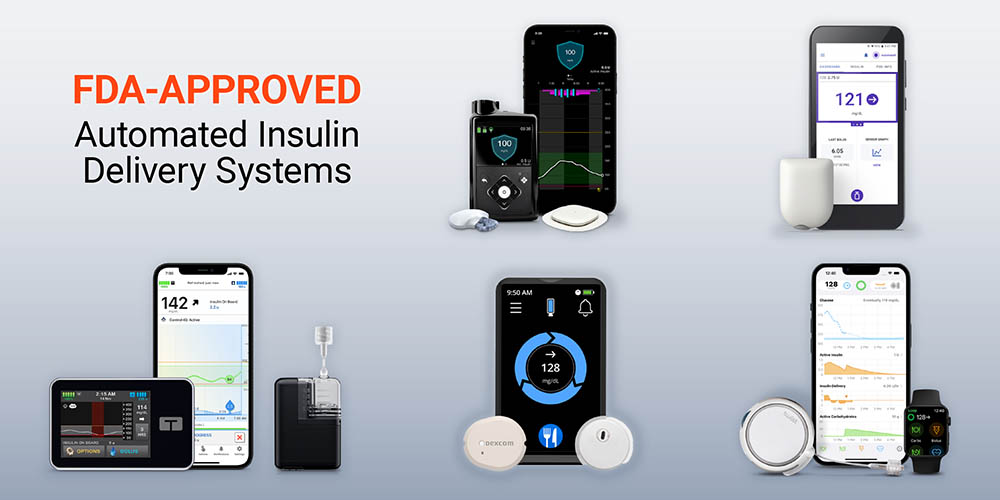
Updated July 14, 2025
- Automated insulin delivery (AID) systems integrate a continuous glucose monitor (CGM), an insulin pump, and an algorithm to automatically adjust insulin delivery based on real-time glucose levels.
- There are five AID systems available in the U.S.: Tandem Control-IQ+, Medtronic MiniMed 780G, Insulet Omnipod 5, Beta Bionics iLet, and Sequel twiist.
- Each system has unique features, but all do an excellent job improving time in range, reducing hypoglycemia, providing better overnight control, and reducing long-term complications.
- Insulin pump manufacturers are ultimately working toward fully closed-loop systems that will require no user input, and more device integrations are expected in the coming years to enhance user choice and flexibility.
Reading Time: 6 minutes
Choosing an automated insulin delivery system is a lot like choosing a mate – you may need to date a few before you find the one you want to be attached to at the hip.
The good news is that all of the automated insulin delivery systems are excellent, and they can really make a difference in helping you stay in your target range for a higher percentage of time with less effort.
What Are Automated Insulin Delivery Systems?
AID systems – also known as hybrid closed-loop insulin pump systems – combine a continuous glucose monitor (CGM), an insulin pump, and an algorithm to automatically adjust insulin delivery based on real-time glucose levels.
There are five main automated insulin delivery systems on the market in the United States:
We’re going to take a detailed look at each system, including notable features, continuous glucose monitor integrations, and overall pros and cons.
Medtronic MiniMed 780G System
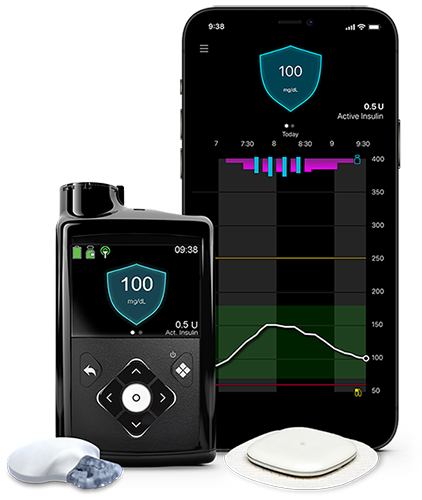
Medtronic’s MiniMed 780G has an aggressive algorithm that includes Meal Detection technology. This is an advanced feature that uses current and past glucose trends to detect a missed meal dose. It’s a lot more forgiving than other systems if you forget to bolus.
The MiniMed 780G can predict glucose values several hours into the future, which allows for adjustments to the insulin being infused.
Later this year, the MiniMed 780G will be getting an upgraded continuous glucose monitor sensor with a better form factor called Simplera Sync. Medtronic also announced a unique global partnership with Abbott to collaborate on an iCGM system based on Abbott’s FreeStyle Libre technology that will connect with Medtronic’s AID and smart insulin pen systems in the future.
.
Notable Features
- Basal and bolus adjustments every 5 minutes
- Meal Detection technology uses current and past glucose trends to detect a missed meal dose
- SmartGuard technology automatically adjusts basal insulin delivery based on your sensor glucose values to protect against highs and lows
- SmartGuard technology can be used in manual or auto mode, and it can also automatically stop and resume insulin delivery based on your values and low limit
- The MiniMed 780G allows you to set a target as low as 100 mg/dL — one of the lowest on the market
CGM Integrations
- Medtronic’s Guardian 4 Sensor
- Coming soon: Medtronic’s Simplera Sync sensor and Abbott’s FreeStyle Libre technology
Pros
- One of the most aggressive automated insulin delivery system algorithms on the market
- One of the lowest glucose target setting available (100 mg/dL)
- Extended infusion set can be worn for up to 7 days
Cons
- Tubing can be inconvenient for some people
- The current Guardian 4 sensor has a difficult form factor due to its size, the need for charging, and seven day lifespan
Tandem Control-IQ+
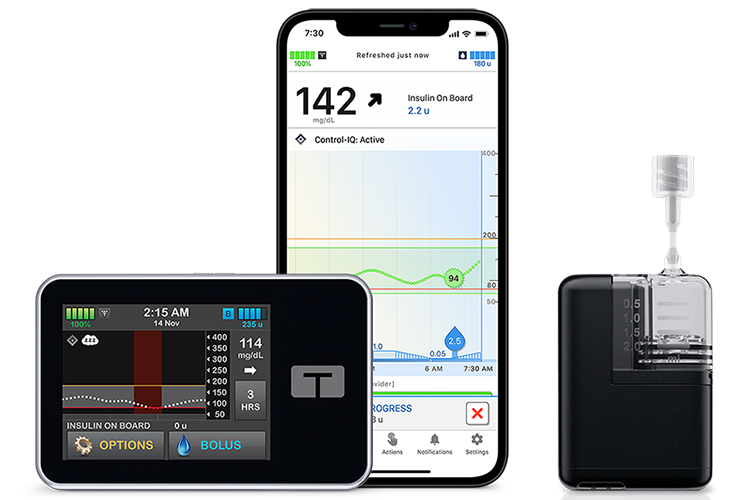
Tandem Control-IQ+ is one of the most widely used AID systems. It has an advanced algorithm that automatically adjusts basal insulin delivery and gives correction boluses.
It works with Tandem’s two tubed insulin pumps – t:slim X2 and Mobi. The t:slim X2 has a touch screen on the pump and holds 300 units of insulin. Mobi is smaller and can be worn on the body (though it still has a tube). It holds 200 units of insulin and is controlled solely with a smartphone app – there’s no user interface on the pump itself.
Control IQ+ is approved for ages 2+ and was also just recently approved for people with type 2 diabetes on insulin.
Notable Features
- Temp Basal Rate: Option to personalize insulin delivery for changing needs during automation
- AutoBolus: If glucose is predicted to be above 180 mg/dL, an automatic correction bolus will be delivered
- Extended Bolus: Option to extend a bolus for up to eight hours
- Sleep Activity: Uses a narrower and lower range of treatment values to help guard against lows and highs while sleeping
- Exercise Activity: Uses a narrower and higher range of treatment values to help guard against lows during activity
CGM Integrations
Control-IQ+ is compatible with:
- All versions of Dexcom G6 for both t:slim and Mobi
- Specific versions of Dexcom G7 for both t:slim X2 and Mobi
- Abbott’s FreeStyle Libre 2 Plus sensor with t:slim X2
Pros
- The only automated insulin delivery system with an extended bolus for up to eight hours during automated insulin delivery
- Two different choices for preferred form factor – t:slim X2 or Mobi
- It’s tried and true – Tandem’s first t:slim pump was FDA approved in 2011
Cons
- Requires tubing (as all of these systems do, except for the Omnipod), which may not be a con for everyone
- Infusion sets must be replaced and rotated every 2-3 days (typical for most tubing)
Insulet Omnipod 5
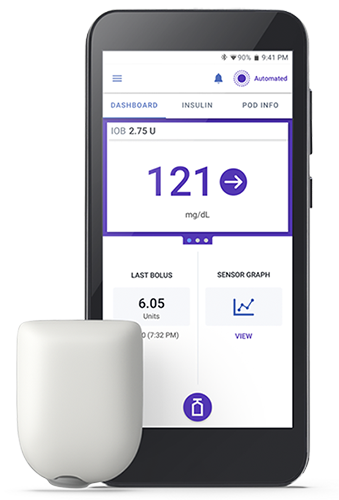
The Omnipod 5 is the only tubeless patch pump on the market. It can be worn almost anywhere on the body, and it has a simpler setup compared to tubed pumps.
Omnipod 5 has an adaptive basal feature called SmartAdjust technology, which is calculated from the total daily insulin use and updated every three days at each Pod change.
Omnipod 5 is controlled with a smartphone app (or separate controller) and is cleared for people with type 1 diabetes ages 2+, and those with type 2 diabetes who are at least 18 years old.
Notable Features
- SmartAdjust technology: Predicts future glucose levels up to 60 minutes ahead using your continuous glucose monitor sensor value and trend
- Bolus doses can be given for meals using the Omnipod 5 app on your smartphone, or with the controller
- You can set glucose targets between 110–150 mg/dL
- The Pod has a waterproof IP28 rating for up to 25 feet for 60 minutes
CGM Integrations
- Dexcom G6 and Dexcom G7
- Abbott’s FreeStyle Libre 2 Plus sensor
Pros
- No tubing – discrete and easy to wear almost anywhere on the body
- Learns and adapts over time to your personal glucose patterns and insulin requirements
- Disposable pump (no need to charge it)
Cons
- Pods stop working after 80 hours and must be replaced
- The Pod holds 200 units of insulin and requires a minimum of 85 units to operate
Beta Bionics iLet Bionic Pancreas
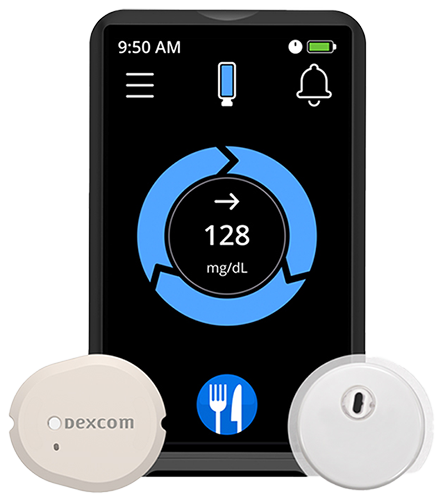
The iLet Bionic Pancreas is unique because there are no settings, which means it’s a very hands off automated insulin delivery device. When you start on the system, the only thing you enter is your weight. There’s no correction factor, insulin-to-carb ratio, or basal rate. You just make simple meal announcements when you eat. The algorithm takes a week or two to learn about you, and then you’re set!
Notable Features
- Requires only weight as an initial input and adapts its dosing decisions over time
- No carb counting needed – you just announce meals as “breakfast”, “lunch”, or “dinner”, and enter a size as “usual”, “more”, or “less”
- Glucose target can be set between 110 and 130 mg/dL, and can be adjusted throughout the day as needed
CGM Integrations
- Dexcom G6 and Dexcom G7
- Abbott’s FreeStyle Libre 3 Plus sensor
Pros
- Simple setup – requires only your weight
- No carb counting
- Reduced decision fatigue
Cons
- No insulin adjustments for exercise
- If you’re high, you have to be patient and let the algorithm bring you back down to the desirable range (no correction doses)
Sequel Twiist
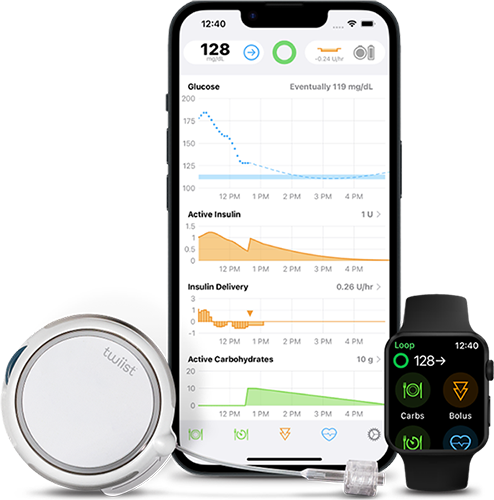
The twiist received FDA approval in March of 2024, so it’s the newest automated insulin delivery system on the block. It uses a sophisticated algorithm based on Tidepool Loop, so it’s very similar to the devices that use open source “Looping”. It directly measures the volume of insulin delivered with every dose, allowing for precise, tailored insulin management. The twiist is a tubed pump that’s small and light, yet holds 300 units of insulin. It launched in select areas of the U.S. on July 7th, 2025, with nationwide availability expected by the end of the year.
Notable Features
- Updates predictions every 5 minutes to create a 6-hour glucose forecast
- Glucose targets available from 87-180 mg/dL
- Insulin dosage adjustments can be made by selecting emojis
- Half of the pump holds the insulin cartridge, which can be twisted off for disposal
CGM Integration
- Compatible with Abbott’s FreeStyle Libre 3 Plus sensor
- Integration with Eversense 365 expected in the third quarter of 2025
Pros
- Sophisticated algorithm
- Small, lightweight, and water resistant up to 12 feet for one hour
- Holds 300 units of insulin and has enhanced blockage detection
Cons
- Currently only available for iPhone users (in select areas)
Loop is not indicated for use by anyone who is pregnant, on dialysis, or critically ill
How to Choose the Right Automated Insulin Delivery System for You
Here are some questions to consider as you compare various systems:
- Do you prefer a tubed or tubeless pump?
- Is the pump compatible with your current continuous glucose monitor?
- How does the automated system adjust insulin delivery?
- Can you customize settings?
- Is the pump’s interface easy to navigate?
- What infusion set options are available?
- How long is the warranty period?
- Which system is covered by your insurance?
- How easy is the system to set up every 3-7 days?
Takeaways
All of these automated insulin delivery systems do a fantastic job improving time in range, reducing hypoglycemia risk, providing better overnight control, reducing long-term complications, and offering flexibility and peace of mind.
Pump manufacturers are working toward systems that won’t require any patient input (i.e. carbs or meal announcements), aiming to create fully closed-loop systems (as opposed to hybrid closed-loop insulin pump systems). This technology could become a reality in the next few years.
Some pump manufacturers are also developing dual-hormone AID systems that deliver both insulin and glucagon.
In the meantime, device companies are continuously working on more integrations, so soon we’ll be able to pick from an even wider variety of pumps and sensors that can all work together.
Choosing an automated insulin device may seem overwhelming, but the bottom line is that anyone can have success and benefit from any of the AID systems.
Please visit our video vault for more resources on diabetes management and automated insulin delivery systems.

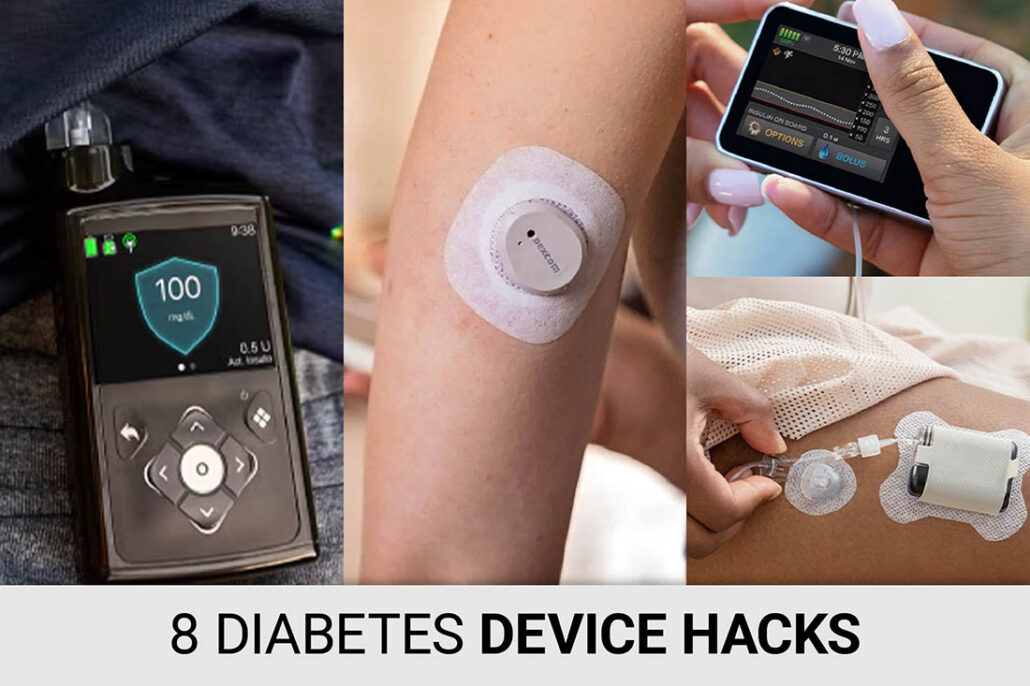

I love my Tandem / Dexcom G7 system. I have been on this closed-loop system for 4 years and was on my previous system 11 years. Due to my medical /insurance coverage I didn’t realize other pumping systems were available. This is my second system automated system. Previous to the Tandem system I was on the Medtronic system and the CGM linkage with the pump was not very user friendly. It had me constantly doing finger checks for calibration (6-10 times daily) based on information provided to me from prompts on the pump screen. Technical support didn’t help out that much, nor did the people who trained me on the use of their product. Downloading was a pain. I paid dearly for this pump and it was ok, but I was encouraged to replace it for a more tech savvy pump and they wanted me to mail them my old pump. The new pump did have more features but didn’t do anything to help me with better BG control. Tandem Control IQ is great but as with all pumps you must learn them and work with your Endo. to get your pump settings tweaked for the best possible control. I also work with a dietitian whop also helps to analyze my pump reports so we both make the changes to the pump setting so I understand why certain changes make sense. Whatever system you choose to use you must have a good and knowledgeable Endo. who will work with you and can analyze the pump and CGM printout to help you get the best possible control without having hypo or hyper episodes.
Thanks for your comments, Roy. They are all good systems and you have to find the one that’s right for you. Glad you also have a good endo and dietitian to help with the settings!
I am type 2 diabetic. I inject insulin every evening. (20 units).
1. How does blood get to monitor?
2. How often does it have to be replaced?
3. Is it cumbersome, have to be careful about movement?
4. Does Medicare pay for all,or part?
The sensor works the same way as when you prick your finger, except it’s just under the skin. The time frame of swapping out sensors varies per device. Medicare covers many devices but you’ll need to check with your own policy and the specific device you’re interested in.
Hi! I did a quick check on the iLet Bionic since it interested me the most and was a little disappointed to discover that it was “tubed”. I’m currently using Dexcom CGM/Omnipod 5 and have been for a while now, but I find thinking about and doing “diabetes management” to be quite a chore so the ilet Bionic seemed especially attractive. My biggest hang-up at the moment is bulky design of the Omnipod while the iLet looked more sleek – it sits lower on the body it seems. I appreciate the article as it was informative.
If I were you, I would check out the twiist, because it’s small and they will have a patch where you can wear it kind of like a patch pump with very short tubing. But once you get your settings set on the Omnipod, there’s really not much to think about. Here’s a link to the twiist if you want to check it out:
https://www.sequelmedtech.com/
I’ve been a T1D for over fifty years and have using Medtronic pumps for over twenty years. The 780G that I currently use is pure magic. The calibration issues of earlier Medtronic pumps/sensors have been sorted out and the Guardian 4 is very reliable. The only issue is the tick like attachment of the sensor. It has always been a bad design. I used a Dexcom in the early CGM days before I went on a pump and it was always better. It will be interesting to see the new sensor option is like. I’m not sure I would ever want to use a pump with no provision for manual override.
Hi Bill,
Thanks for your comment! We’re looking forward to the new Simplera sensor also, as well as the new sensor that’s being designed by Abbott. If you do try one when they become available, please let us know what you think!